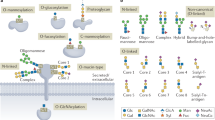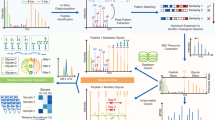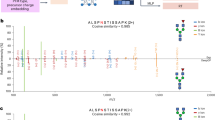Abstract
N-glycans contribute to the folding, stability and functions of the proteins they decorate. They are produced by transfer of the glycan precursor to the sequon Asn-X-Thr/Ser, followed by enzymatic trimming to a high-mannose-type core and sequential addition of monosaccharides to generate complex-type and hybrid glycans. This process, mediated by the concerted action of multiple enzymes, produces a mixture of related glycoforms at each glycosite, making analysis of glycosylation difficult. To address this analytical challenge, we developed a robust semiquantitative mass spectrometry (MS)-based method that determines the degree of glycan occupancy at each glycosite and the proportion of N-glycans processed from high-mannose type to complex type. It is applicable to virtually any glycoprotein, and a complete analysis can be conducted with 30 μg of protein. Here, we provide a detailed description of the method that includes procedures for (i) proteolytic digestion of glycoprotein(s) with specific and nonspecific proteases; (ii) denaturation of proteases by heating; (iii) sequential treatment of the glycopeptide mixture with two endoglycosidases, Endo H and PNGase F, to create unique mass signatures for the three glycosylation states; (iv) LC-MS/MS analysis; and (v) data analysis for identification and quantitation of peptides for the three glycosylation states. Full coverage of site-specific glycosylation of glycoproteins is achieved, with up to thousands of high-confidence spectra hits for each glycosite. The protocol can be performed by an experienced technician or student/postdoc with basic skills for proteomics experiments and takes ∼7 d to complete.
This is a preview of subscription content, access via your institution
Access options
Access Nature and 54 other Nature Portfolio journals
Get Nature+, our best-value online-access subscription
$32.99 / 30 days
cancel any time
Subscribe to this journal
Receive 12 print issues and online access
$259.00 per year
only $21.58 per issue
Buy this article
- Purchase on SpringerLink
- Instant access to full article PDF
Prices may be subject to local taxes which are calculated during checkout






Similar content being viewed by others
References
Helenius, A. & Aebi, M. Intracellular functions of N-linked glycans. Science 291, 2364–2369 (2001).
Mathys, L., Francois, K.O., Quandte, M., Braakman, I. & Balzarini, J. Deletion of the highly conserved N-glycan at Asn260 of HIV-1 gp120 affects folding and lysosomal degradation of gp120, and results in loss of viral infectivity. PLoS ONE 9, e101181 (2014).
Rudd, P.M., Elliott, T., Cresswell, P., Wilson, I.A. & Dwek, R.A. Glycosylation and the immune system. Science 291, 2370–2376 (2001).
Ohtsubo, K. & Marth, J.D. Glycosylation in cellular mechanisms of health and disease. Cell 126, 855–867 (2006).
Balog, C.I.A. et al. N-glycosylation of colorectal cancer tissues. Mol. Cell Proteomics 11, 571–585 (2012).
de Leoz, M.L.A. et al. High-mannose glycans are elevated during breast cancer progression. Mol. Cell Proteomics 10 http://www.grits-toolbox.org/ (2011).
de Vries, R.P. et al. The influenza A virus hemagglutinin glycosylation state affects receptor-binding specificity. Virology 403, 17–25 (2010).
Khatri, K. et al. Integrated omics and computational glycobiology reveal structural basis for influenza A virus glycan microheterogeneity and host interactions. Mol. Cell. Proteomics 15, 1895–1912 (2016).
Wanzeck, K., Boyd, K.L. & McCullers, J.A. Glycan shielding of the influenza virus hemagglutinin contributes to immunopathology in mice. Am. J. Resp. Crit. Care 183, 767–773 (2011).
Cao, L.W. et al. Global site-specific N-glycosylation analysis of HIV envelope glycoprotein. Nat. Commun. 8, 14954 (2017).
Falkowska, E. et al. Broadly neutralizing HIV antibodies define a glycan-dependent epitope on the prefusion conformation of gp41 on cleaved envelope trimers. Immunity 40, 657–668 (2014).
Julien, J.P. et al. Broadly neutralizing antibody PGT121 allosterically modulates CD4 binding via recognition of the HIV-1 gp120 V3 base and multiple surrounding glycans. PLoS Pathog. 9, e1003342 (2013).
Garces, F. et al. Structural evolution of glycan recognition by a family of potent HIV antibodies. Cell 159, 69–79 (2014).
Sok, D. et al. Promiscuous glycan site recognition by antibodies to the high-mannose patch of gp120 broadens neutralization of HIV. Sci. Transl. Med. 6, 236ra63 (2014).
Blattner, C. et al. Structural delineation of a quaternary, cleavage-dependent epitope at the gp41-gp120 interface on intact HIV-1 Env trimers. Immunity 40, 669–680 (2014).
Morell, A.G., Gregoriadis, G., Scheinberg, I.H., Hickman, J. & Ashwell, G. The role of sialic acid in determining the survival of glycoproteins in the circulation. J. Biol. Chem. 246, 1461–1467 (1971).
Doores, K.J. et al. Envelope glycans of immunodeficiency virions are almost entirely oligomannose antigens. Proc. Natl. Acad. Sci. USA 107, 13800–13805 (2010).
Pritchard, L.K. et al. Structural constraints determine the glycosylation of HIV-1 envelope trimers. Cell Rep. 11, 1604–1613 (2015).
Raska, M. et al. Glycosylation patterns of HIV-1 gp120 depend on the type of expressing cells and affect antibody recognition. J. Biol. Chem. 285, 20860–20869 (2010).
Kong, L. et al. Expression-system-dependent modulation of HIV-1 envelope glycoprotein antigenicity and immunogenicity. J. Mol. Biol. 403, 131–147 (2010).
Vance, B.A., Wu, W., Ribaudo, R.K., Segal, D.M. & Kearse, K.P. Multiple dimeric forms of human CD69 result from differential addition of N-glycans to typical (Asn-X-Ser/Thr) and atypical (Asn-X-cys) glycosylation motifs. J. Biol. Chem. 272, 23117–23122 (1997).
Sun, S.S. & Zhang, H. Identification and validation of atypical N-glycosylation sites. Anal. Chem. 87, 11948–11951 (2015).
Anderson, D.R., Atkinson, P.H. & Grimes, W.J. Major carbohydrate structures at five glycosylation sites on murine IgM determined by high resolution 1H-NMR spectroscopy. Arch. Biochem. Biophys. 243, 605–618 (1985).
Arnold, J.N. et al. Human serum IgM glycosylation - Identification of glycoforms that can bind to mannan-binding lectin. J. Biol. Chem. 280, 29080–29087 (2005).
An, Y., McCullers, J.A., Alymova, I., Parsons, L.M. & Cipollo, J.F. Glycosylation analysis of engineered H3N2 influenza A virus hemagglutinins with sequentially added historically relevant glycosylation sites. J. Proteome Res. 14, 3957–3969 (2015).
Parsons, L.M., An, Y., de Vries, R.P., de Haan, C.A. & Cipollo, J.F. Glycosylation characterization of an influenza H5N7 hemagglutinin series with engineered glycosylation patterns: implications for structure-function relationships. J. Proteome Res. 16, 398–412 (2017).
Go, E.P. et al. Glycosylation benchmark profile for HIV-1 envelope glycoprotein production based on eleven Env trimers. J. Virol. 91 e02428-16 (2017).
Go, E.P. et al. Comparative analysis of the glycosylation profiles of membrane-anchored HIV-1 envelope glycoprotein trimers and soluble gp140. J. Virol. 89, 8245–8257 (2015).
Behrens, A.J. et al. Composition and antigenic effects of individual glycan sites of a trimeric HIV-1 envelope glycoprotein. Cell Rep. 14, 2695–2706 (2016).
Zaia, J. Mass spectrometry and the emerging field of glycomics. Chem. Biol. 15, 881–892 (2008).
Aldredge, D., An, H.J., Tang, N., Waddell, K. & Lebrilla, C.B. Annotation of a serum N-glycan library for rapid identification of structures. J. Proteome Res. 11, 1958–1968 (2012).
Cao, L.W. et al. Sample preparation for mass spectrometric analysis of human serum N-glycans using hydrophilic interaction chromatography-based solid phase extraction. Analyst 139, 4538–4546 (2014).
Pang, P.C. et al. Human sperm binding is mediated by the sialyl-Lewis(x) oligosaccharide on the zona pellucida. Science 333, 1761–1764 (2011).
Ashline, D., Singh, S., Hanneman, A. & Reinhold, V. Congruent strategies for carbohydrate sequencing. 1. Mining structural details by MSn. Anal. Chem. 77, 6250–6262 (2005).
Jiang, H.T., Wu, S.L., Karger, B.L. & Hancock, W.S. Characterization of the glycosylation occupancy and the active site in the follow-on protein therapeutic: TNK-tissue plasminogen activator. Anal. Chem. 82, 6154–6162 (2010).
Bones, J., Mittermayr, S., O′Donoghue, N., Guttman, A. & Rudd, P.M. Ultra performance liquid chromatographic profiling of serum N-Glycans for fast and efficient identification of cancer associated alterations in glycosylation. Anal. Chem. 82, 10208–10215 (2010).
Zauner, G., Deelder, A.M. & Wuhrer, M. Recent advances in hydrophilic interaction liquid chromatography (HILIC) for structural glycomics. Electrophoresis 32, 3456–3466 (2011).
Kolarich, D., Jensen, P.H., Altmann, F. & Packer, N.H. Determination of site-specific glycan heterogeneity on glycoproteins. Nat. Protoc. 7, 1285–1298 (2012).
Huffman, J.E. et al. Comparative performance of four methods for high-throughput glycosylation analysis of immunoglobulin G in genetic and epidemiological research. Mol. Cell Proteomics 13, 1598–1610 (2014).
Zhang, H., Li, X.J., Martin, D.B. & Aebersold, R. Identification and quantification of N-linked glycoproteins using hydrazide chemistry, stable isotope labeling and mass spectrometry. Nat. Biotechnol. 21, 660–666 (2003).
Kaji, H. et al. Lectin affinity capture, isotope-coded tagging and mass spectrometry to identify N-linked glycoproteins. Nat. Biotechnol. 21, 667–672 (2003).
Wada, Y., Tajiri, M. & Yoshida, S. Hydrophilic affinity isolation and MALDI multiple-stage tandem mass spectrometry of glycopeptides for glycoproteomics. Anal. Chem. 76, 6560–6565 (2004).
Deeb, S.J., Cox, J., Schmidt-Supprian, M. & Mann, M. N-linked glycosylation enrichment for in-depth cell surface proteomics of diffuse large B-cell lymphoma subtypes. Mol. Cell Proteomics 13, 240–251 (2014).
Zielinska, D.F., Gnad, F., Wisniewski, J.R. & Mann, M. Precision mapping of an in vivo N-glycoproteome reveals rigid topological and sequence constraints. Cell 141, 897–907 (2010).
Sun, S.S. et al. Comprehensive analysis of protein glycosylation by solid-phase extraction of N-linked glycans and glycosite-containing peptides. Nat. Biotechnol. 34, 84–88 (2016).
Thaysen-Andersen, M., Packer, N.H. & Schulz, B.L. Maturing glycoproteomics technologies provide unique structural insights into the N-glycoproteome and its regulation in health and disease. Mol. Cell Proteomics 15, 1773–1790 (2016).
Yang, N. et al. Quantitation of site-specific glycosylation in manufactured recombinant monoclonal antibody drugs. Anal. Chem. 88, 7091–7100 (2016).
Panico, M. et al. Mapping the complete glycoproteome of virion-derived HIV-1 gp120 provides insights into broadly neutralizing antibody binding. Sci. Rep. 6, 32956 (2016).
Cao, L.W. et al. Application of a strong anion exchange material in electrostatic repulsion-hydrophilic interaction chromatography for selective enrichment of glycopeptides. J. Chromatogr. A 1299, 18–24 (2013).
Sun, B.Y. et al. Shotgun glycopeptide capture approach coupled with mass spectrometry for comprehensive glycoproteomics. Mol. Cell Proteomics 6, 141–149 (2007).
Thaysen-Andersen, M. et al. Human neutrophils secrete bioactive paucimannosidic proteins from azurophilic granules into pathogen-infected sputum. J. Biol. Chem. 290, 8789–8802 (2015).
Cao, L.W. et al. N-glycosylation site analysis of proteins from Saccharomyces cerevisiae by using hydrophilic interaction liquid chromatography-based enrichment, parallel deglycosylation, and mass spectrometry. J. Proteome Res. 13, 1485–1493 (2014).
Wei, X.P. et al. Antibody neutralization and escape by HIV-1. Nature 422, 307–312 (2003).
Sok, D. et al. A prominent site of antibody vulnerability on HIV envelope incorporates a motif associated with CCR5 binding and its camouflaging glycans. Immunity 45, 31–45 (2016).
Burton, D.R. & Hangartner, L. Broadly neutralizing antibodies to HIV and their role in vaccine design. Annu. Rev. Immunol. 34, 635–659 (2016).
McCoy, L.E. & McKnight, A. Lessons learned from humoral responses of HIV patients. Curr. Opin. HIV AIDS 12, 195–202 (2017).
Julien, J.P. et al. Crystal structure of a soluble cleaved HIV-1 envelope trimer. Science 342, 1477–1483 (2013).
Kong, L. et al. Supersite of immune vulnerability on the glycosylated face of HIV-1 envelope glycoprotein gp120. Nat. Struct. Mol. Biol. 20, 796–803 (2013).
Amin, M.N. et al. Synthetic glycopeptides reveal the glycan specificity of HIV-neutralizing antibodies. Nat. Chem. Biol. 9, 521–526 (2013).
Mouquet, H. et al. Complex-type N-glycan recognition by potent broadly neutralizing HIV antibodies. Proc. Natl. Acad. Sci. USA. 109, E3268–E3277 (2012).
Stavenhagen, K. et al. Quantitative mapping of glycoprotein micro-heterogeneity and macro-heterogeneity: an evaluation of mass spectrometry signal strengths using synthetic peptides and glycopeptides. J. Mass Spectrom. 48, 627–639 (2013).
Behrens, A.J. et al. Molecular architecture of the cleavage-dependent mannose patch on a soluble HIV-1 envelope glycoprotein trimer. J. Virol. 91, e01894-16 (2017).
Eshghi, S.T., Shah, P., Yang, W.M., Li, X.D. & Zhang, H. GPQuest: a spectral library matching algorithm for site-specific assignment of tandem mass spectra to intact N-glycopeptides. Anal. Chem. 87, 5181–5188 (2015).
Khatri, K., Klein, J.A. & Zaia, J. Use of an informed search space maximizes confidence of site-specific assignment of glycoprotein glycosylation. Anal. Bioanal. Chem. 409, 607–618 (2017).
Hao, P.L., Ren, Y., Alpert, A.J. & Sze, S.K. Detection, evaluation and minimization of nonenzymatic deamidation in proteomic sample preparation. Mol. Cell. Proteomics 10, O111.00938 (2011).
MacCoss, M.J. et al. Shotgun identification of protein modifications from protein complexes and lens tissue. Proc. Natl. Acad. Sci. USA 99, 7900–7905 (2002).
Angel, P.M., Lim, J.M., Wells, L., Bergmann, C. & Orlando, R. A potential pitfall in 18O-based N-linked glycosylation site mapping. Rapid Comm. Mass Spectrom. 21, 674–682 (2007).
Wolters, D.A., Washburn, M.P. & Yates, J.R. An automated multidimensional protein identification technology for shotgun proteomics. Anal. Chem. 73, 5683–5690 (2001).
Pallesen, J. et al. Immunogenicity and structures of a rationally designed prefusion MERS-CoV spike antigen. Proc. Natl. Acad. Sci. USA 114, E7348–E7357 (2017).
Imre, T. et al. Glycosylation site analysis of human alpha-1-acid glycoprotein (AGP) by capillary liquid chromatography-electrospray mass spectrometry. J. Mass Spectrom. 40, 1472–1483 (2005).
Pabst, M. et al. A microarray-matrix-assisted laser desorption/ionization-mass spectrometry approach for site-specific protein N-glycosylation analysis, as demonstrated for human serum immunoglobulin M (IgM). Mol. Cell Proteomics 14, 1645–1656 (2015).
Tang, N.L.S. Chemical diagnostics from bench to bedside preface. Top. Curr. Chem. 336, V–VI (2014).
Satomi, Y., Shimonishi, Y., Hase, T. & Takao, T. Site-specific carbohydrate profiling of human transferrin by nano-flow liquid chromatography/electrospray ionization mass spectrometry. Rapid Commun. Mass Spectrom. 18, 2983–2988 (2004).
Nilsson, J. et al. Enrichment of glycopeptides for glycan structure and attachment site identification. Nat. Methods 6, 809–811 (2009).
Hulsmeier, A.J., Tobler, M., Burda, P. & Hennet, T. Glycosylation site occupancy in health, congenital disorder of glycosylation and fatty liver disease. Sci. Rep. 6, 33927 (2016).
Guttman, M. et al. CD4-induced activation in a soluble HIV-1 Env trimer. Structure 22, 974–984 (2014).
Pancera, M. et al. Structural basis for diverse N-glycan recognition by HIV-1-neutralizing V1-V2-directed antibody PG16. Nat. Struct. Mol. Biol. 20, 804–813 (2013).
McLellan, J.S. et al. Structure of HIV-1 gp120 V1/V2 domain with broadly neutralizing antibody PG9. Nature 480, 336–343 (2011).
Acknowledgements
This work was supported by National Institutes of Health (NIH) grants R01AI113867 (J.C.P., J.R.Y. and W.R. Schief), UM1 AI100663 (D.R.B. and J.C.P.), R01AI127521 (J.S.M.), and P41 GM103533 (J.R.Y.).
Author information
Authors and Affiliations
Contributions
L.C., J.R.Y., and J.C.P. designed the research. L.C. prepared samples for MS analysis. J.K.D., L.C., C.M.D., and Y.M. performed the MS analysis. L.C. and S.-K.R.P. analyzed the data. N.W. and M.P. expressed and purified Env proteins. J.S.M., D.R.B., J.R.Y., and J.C.P. supervised the project. L.C. and J.C.P. wrote the manuscript.
Corresponding author
Ethics declarations
Competing interests
The authors declare no competing financial interests.
Integrated supplementary information
Supplementary Figure 1 Identification of peptides with multiple glycosylation sites with the protocol.
MS/MS spectra and fragment assignment of the (a) di-glycosylated, (b) tri-glycosylated, and (c) tetra-glycosylated peptides derived from BG505 SOSIP.664.
Supplementary Figure 2 Scatter plot of site-specific N-glycan processing of MERS-CoV S protein with a breakdown on the used proteases.
(a) Triple digestion, (b) the combination of trypsin and chymotrypsin, (c) chymotrypsin. The proportions of high mannose and complex type glycans at those glycosites highlighted in yellow were assigned based on the proportion of spectra hits since peak area did not reach the threshold. Mean ± SEM were plotted.
Supplementary information
Supplementary Text and Figures
Supplementary Figures 1 and 2, and Supplementary Tables 1–5. (PDF 503 kb)
Rights and permissions
About this article
Cite this article
Cao, L., Diedrich, J., Ma, Y. et al. Global site-specific analysis of glycoprotein N-glycan processing. Nat Protoc 13, 1196–1212 (2018). https://doi.org/10.1038/nprot.2018.024
Published:
Issue date:
DOI: https://doi.org/10.1038/nprot.2018.024
This article is cited by
-
Mechanisms underlining Kelp (Saccharina japonica) adaptation to relative high seawater temperature
BMC Genomics (2025)
-
Study of β1-transferrin and β2-transferrin using microprobe-capture in-emitter elution and high-resolution mass spectrometry
Scientific Reports (2023)
-
Glucose-mediated N-glycosylation of RPTPα affects its subcellular localization and Src activation
Oncogene (2023)
-
The glycosylation in SARS-CoV-2 and its receptor ACE2
Signal Transduction and Targeted Therapy (2021)
-
Yeast-produced RBD-based recombinant protein vaccines elicit broadly neutralizing antibodies and durable protective immunity against SARS-CoV-2 infection
Cell Discovery (2021)



